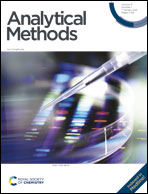Presence of anthraquinone in coffee and tea samples. An improved methodology based on mass spectrometry and a pilot monitoring programme†
Abstract
Anthraquinone has been linked to potential adverse effects on human health and the environment. The most commonly employed methods for the analysis of coffee and tea cause the extraction of matrix interferents such as the methylxanthines caffeine and theobromine, which hinder the analysis of anthraquinone. A new manual extraction method – using ethyl acetate as the extraction solvent with a dispersive solid-phase extraction clean-up step based on primary–secondary amines – has been developed. The new developed method allows for the quantitation of anthraquinone at 5 μg kg−1 concentration levels, four times lower than the current maximum residue limit for coffee and tea in the European Union (20 μg kg−1). Alongside, a new automated extraction method has also been developed. Finally, a pilot monitoring programme of 90 coffee and tea samples from several countries within the European Union has been performed, in which anthraquinone has been detected in a concentration range of 5.1–18.8 μg kg−1 in 32% of the monitored samples, below the current 20 μg kg−1 maximum residue limit, and in 48% of the monitored tea samples, revealing the need for including anthraquinone in a more extensive monitoring programme of tea.



 Please wait while we load your content...
Please wait while we load your content...